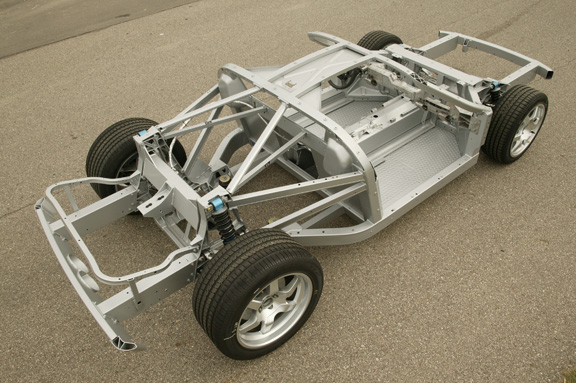2004 Ford GT: An early training ground for the Ford F150
With the aluminum intensive Ford F150 pickup now hitting showrooms, it's fun to reflect on the aluminum-intensive vehicle that Ford was rolling out just 10 years ago - the Ford GT. The GT, inspired by Ford's LeMans winning GT40 of the 1960's, was designed to highlight Ford's expertise for the company's centennial year. Initial production vehicles hit the market in late 2004, and when the planned limited production run ended in late 2006, just over 4,000 had been produced -- less than 1/3 of the quantity of F150s that will be built each week!
The GT's specs vary a bit from the F150 as well:
GT |
F150 |
|
| Passengers: | 2 |
6 (crew cab) |
| Payload (pounds): | minimal |
3300 |
| Weight (pounds): | 3350 |
4300 (4x4) |
| Horsepower: | 550 |
385 max. |
| 0-60 time (seconds): | 3.5 |
6.5 (2.7L EcoBoost) |
| Top Speed (mph): | 205 |
n/a |
| Fuel economy (mpg - highway): | 19 |
26 Highway (2.7L EcoBoost) |
| Price (2014 $): | $177,000 |
$26,500 - $51,500 |
Obviously, there are some huge differences between the two; but there are some similarities as well. Both make extensive use of extrusions, and other forms of aluminum.
 The GT featured an aluminum space frame chassis comprised of 35 extrusions, multiple stamped aluminum sheet panels and a variety of complex aluminum castings which anchored the corners and served as suspension mounting points. Extrusions also provided structural support for the engine compartment and were integrated into the crash management system. The center tunnel was fabricated of two extrusions joined to aluminum sheet with Friction Stir Welding. The extrusions throughout were 6061-T6 or 6063-T6, produced to half of industry standard tolerances.
The GT featured an aluminum space frame chassis comprised of 35 extrusions, multiple stamped aluminum sheet panels and a variety of complex aluminum castings which anchored the corners and served as suspension mounting points. Extrusions also provided structural support for the engine compartment and were integrated into the crash management system. The center tunnel was fabricated of two extrusions joined to aluminum sheet with Friction Stir Welding. The extrusions throughout were 6061-T6 or 6063-T6, produced to half of industry standard tolerances.
Similarly, the F150 uses approximately 40 extruded components, in 6000-series alloy, in a variety of structural applications.
The Ford engineering team working on the GT recognized the potential for aluminum and extrusions. Matt Zaulzec, then Ford's manager of Materials Research and Advanced Engineering noted: "Aggressive targets were set for weight and performance, directly influencing fuel consumption. These targets could not have been achieved without using extrusions."
Similarly, Huibert Mees, the Ford GT Chassis System Supervisor, stated: "With...demands for more fuel-efficient vehicles increasing, aluminum will continue to play an import strategic role in reducing vehicle weight. Aluminum extrusions offer one of the lowest investment options for getting aluminum into the vehicle."
It seems that both have carried their GT experience with them. Zaulzec is currently Technical Advisor to the Vice President, Ford Research and Innovation, and has been deeply involved in both the F150 development and in the development of Ford's lightweight vehicle concept car.
Mees left Ford and is currently Chassis Systems Technical Fellow at Tesla, where he had a major responsibility for the design and engineering of the chassis for the breakthrough Model S (see the AEC Homepage Feature on the model S here).
For a more extensive, contemporary discussion of the Ford GT, and the GT40 that inspired it, go to aec.org/pdfs/ShwcsFrdGTfinal.pdf
And, for a sneak peek at the next generation Ford GT unveiled at the 2015 North American International Auto Show in Detroit, go here: http://www.autofieldguide.com/blog/post/2015-naias-seen-or-scene.
Read the AEC article in Design News, "From the Ford GT to the F-150: Aluminum Extrusion Aids Auto Lightweighting"
Photos: © Ford Motor Company. Used with permission of Ford Motor Company.
 -
-




 |
|